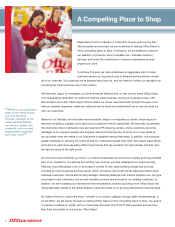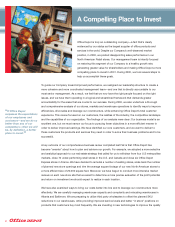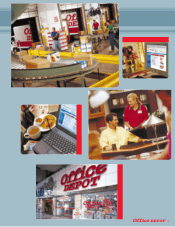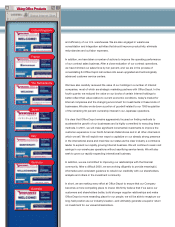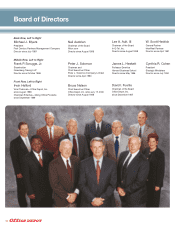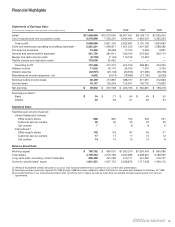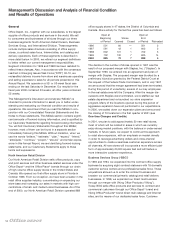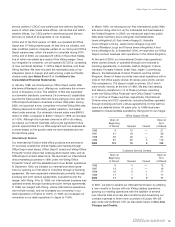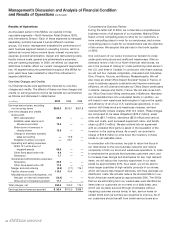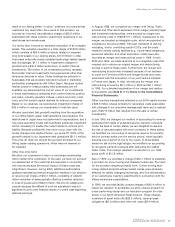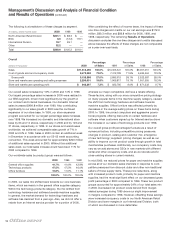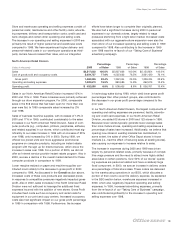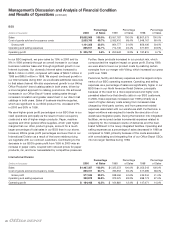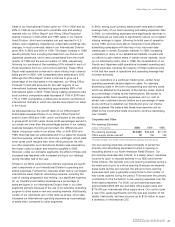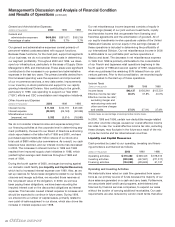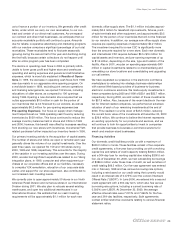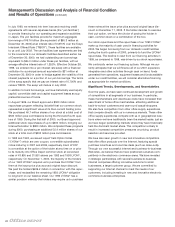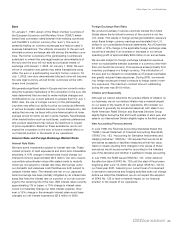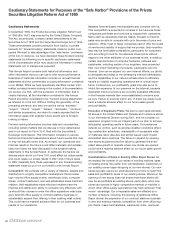Office Depot 2000 Annual Report Download - page 18
Download and view the complete annual report
Please find page 18 of the 2000 Office Depot annual report below. You can navigate through the pages in the report by either clicking on the pages listed below, or by using the keyword search tool below to find specific information within the annual report.
16
Management’s Discussion and Analysis of Financial Condition
and Results of Operations (continued)
Results of Operations
As discussed earlier in this MD&A, we operate in three
reportable segments—North American Retail Division, BSG,
and International Division. Each of these segments is managed
separately, primarily because it serves different customer
groups. Our senior management evaluates the performance of
each business segment based on operating income, which is
defined as income before income taxes, interest income and
expense, goodwill amortization, merger and restructuring costs,
facility closure costs, general and administrative expenses,
and pre-opening expenses. In 2000, we refined our segment
definitions to better reflect our current management responsibili-
ties. All segment amounts presented throughout this MD&A for
prior years have been restated to reflect this refinement in
segment definitions.
One-time Charges and Credits
Our financial results were significantly impacted by one-time
charges and credits. The effects of these one-time charges and
credits on earnings before income tax benefits are summarized
as follows and discussed in detail below:
(In millions) 2000 1999 1998
Earnings before taxes, excluding
non-recurring items $353.0 $519.1 $507.8
One-time charges and credits
Gross profit:
SKU rationalization 25.6 ——
Establish sales returns and
allowance provision 10.5 ——
Write-down of inventory in
closing stores 12.8 ——
Change in extended warranty
sales accounting —15.8 —
Establish inventory provision —56.1 —
Operating and selling expenses:
SFAS 121 write-down of
impaired assets 56.6 ——
Other fixed asset write-offs 6.4 ——
Severance 1.7 ——
General and administrative expenses:
Severance 33.9 ——
Other fixed asset write-offs 11.2 ——
Merger and restructuring (6.8) (7.1) 119.1
Facility closure costs 110.0 40.4 —
Miscellaneous (income) expense, net:
Net gain on Internet investments (12.4) ——
Write-down of impaired goodwill 11.1 ——
Total charges, net 260.6 105.2 119.1
Earnings before taxes as reported $ 92.4 $413.9 $388.7
Comprehensive Business Review
During the latter half of 2000, we conducted a comprehensive
business review of all aspects of our business. Making Office
Depot a more compelling place to shop for our customers, a
more compelling place to work for our employees, and a more
compelling place to invest for our shareholders was the objective
of this review. We adopted this plan late in the fourth quarter
of 2000.
One conclusion of our review involved our decision to close
under-performing stores and inefficient warehouses. After an
extensive review of all of our North American retail stores, we
are in the process of closing 67 under-performing retail stores in
the U.S. and three in Canada. In connection with these closings,
we will exit four markets completely—Cleveland and Columbus,
Ohio, Phoenix, Arizona, and Boston, Massachusetts. We will
also close six small Office Deport ExpressTstores in France. In
order to address capacity constraints and improve warehouse
efficiency, we will close and relocate our Office Depot warehouses
in Atlanta, Georgia and Pantin, France. We will also close both
our Office Depot and Viking warehouses in Baltimore, Maryland
and consolidate them into a relocated facility. In addition, we
will invest in new warehouse technologies to improve the quality
and efficiency of all of our U.S. warehouse operations. In con-
nection with these store and warehouse closures, we have
recorded facility closure charges of $110.0 million. These charges
are comprised of net lease obligations ($75.2 million), asset
write-offs ($21.7 million), severance ($2.8 million) and various
other exit costs, such as leased equipment, labor, and facility
clean-up ($10.3 million). We also entered into an agreement
with an unrelated third party to assist in the liquidation of the
inventory in the closing stores. As a result, we recorded a
charge of $12.8 million to write down the inventory in those
stores to net realizable value.
In connection with this review, we plan to return the focus in
our retail stores to the core business customer and reduce
complexity in both our store and warehouse operations. In order
to emphasize the products that business customers want, and
to increase linear facings and shelf space for key, high demand
items, we will reduce the inventory assortment in our retail
stores by approximately 20%. As a result, we will be able to
stock larger quantities of high velocity products in our stores,
which will require less frequent deliveries, and thus decrease our
distribution costs. We will also reduce the stocked SKUs in our
North American warehouses by approximately 30%. The SKUs
that we are eliminating from our warehouses were identified as
items that our customers do not need on a daily basis, and
which can be easily sourced through wholesalers without
impacting customer service levels. In fact, service levels on
certain items such as furniture are expected to improve. All of
our customers should benefit from better service levels as a


